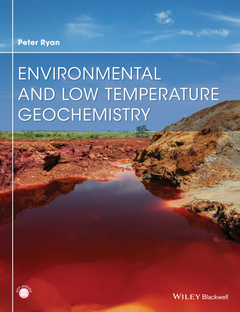Description
Environmental and Low Temperature Geochemistry
Author: Ryan Peter
Language: English
Subjects for Environmental and Low Temperature Geochemistry:
Keywords
geochemistry; quantitative; order; natural; principles; processes; anthropogenic; environment; impacts; concentration; reader; essentials; elements; soils; reactivity; thermodynamic; attention; explanation
Publication date: 05-2014
416 p. · 18.8x24.6 cm · Paperback
Approximative price 139.10 €
In Print (Delivery period: 12 days).
Add to cartPublication date: 05-2014
416 p. · 19.4x25.3 cm · Hardback
Description
/li>Contents
/li>Biography
/li>
Environmental and Low-Temperature Geochemistry presents conceptual and quantitative principles of geochemistry in order to foster understanding of natural processes at and near the earth’s surface, as well as anthropogenic impacts on the natural environment. It provides the reader with the essentials of concentration, speciation and reactivity of elements in soils, waters, sediments and air, drawing attention to both thermodynamic and kinetic controls. Specific features include:
• An introductory chapter that reviews basic chemical principles applied to environmental and low-temperature geochemistry
• Explanation and analysis of the importance of minerals in the environment
• Principles of aqueous geochemistry
• Organic compounds in the environment
• The role of microbes in processes such as biomineralization, elemental speciation and reduction-oxidation reactions
• Thorough coverage of the fundamentals of important geochemical cycles (C, N, P, S)
• Atmospheric chemistry
• Soil geochemistry
• The roles of stable isotopes in environmental analysis
• Radioactive and radiogenic isotopes as environmental tracers and environmental contaminants
• Principles and examples of instrumental analysis in environmental geochemistry.
PART I: FUNDAMENTAL PRINCIPLES AND EARTH MATERIALS.
Chapter 1. Basic chemical principles: elements, ions, bonding, reactions.
Chapter 2. Surficial and environmental mineralogy.
Chapter 3. Biomineralization.
Chapter 4. Organic Geochemistry.
Chapter 5. Aqueous Systems.
Chapter 6: The Carbonate system: Inorganic carbon in the atmosphere, solutions, and minerals.
Chapter 7. Isotope Geochemistry.
PART II: EARTH-SURFACE SYSTEMS.
Chapter 8. The Atmosphere, Climate and Precipitation.
Chapter 9. Weathering, Soils and the Vadose Zone.
Chapter 10. Streams and Lakes.
Chapter 11. The Oceans.
Chapter 12. Aquifer Geochemistry.
Chapter 13. Sediments, Diagenesis and Deep Ground Water.
Chapter 14. Global Geochemical Cycles and Anthropogenic Impacts.
Peter Crowley Ryan is Professor of Geology and Environmental Studies at Middlebury College where he teaches courses in environmental geochemistry, hydrology, sedimentary geology and interdisciplinary environmental science. He received a Ph.D. in geology at Dartmouth College, an M.S. in geology from the University of Montana and a B.A. in earth sciences from Dartmouth College. He has served as Director of the Program in Environmental Studies and as Chair of the Department of Geology at Middlebury College. His research interests fall into two main areas: (1) understanding the geological and mineralogical controls on trace element speciation, particularly the occurrence and mobility of arsenic and uranium in bedrock aquifers; and (2) the temporal evolution of marine terrace soils in the tropics, with emphasis on mechanisms and rates of mineralogical reactions, nutrient cycling and application of soil geochemical analysis to correlation and geological interpretation.

